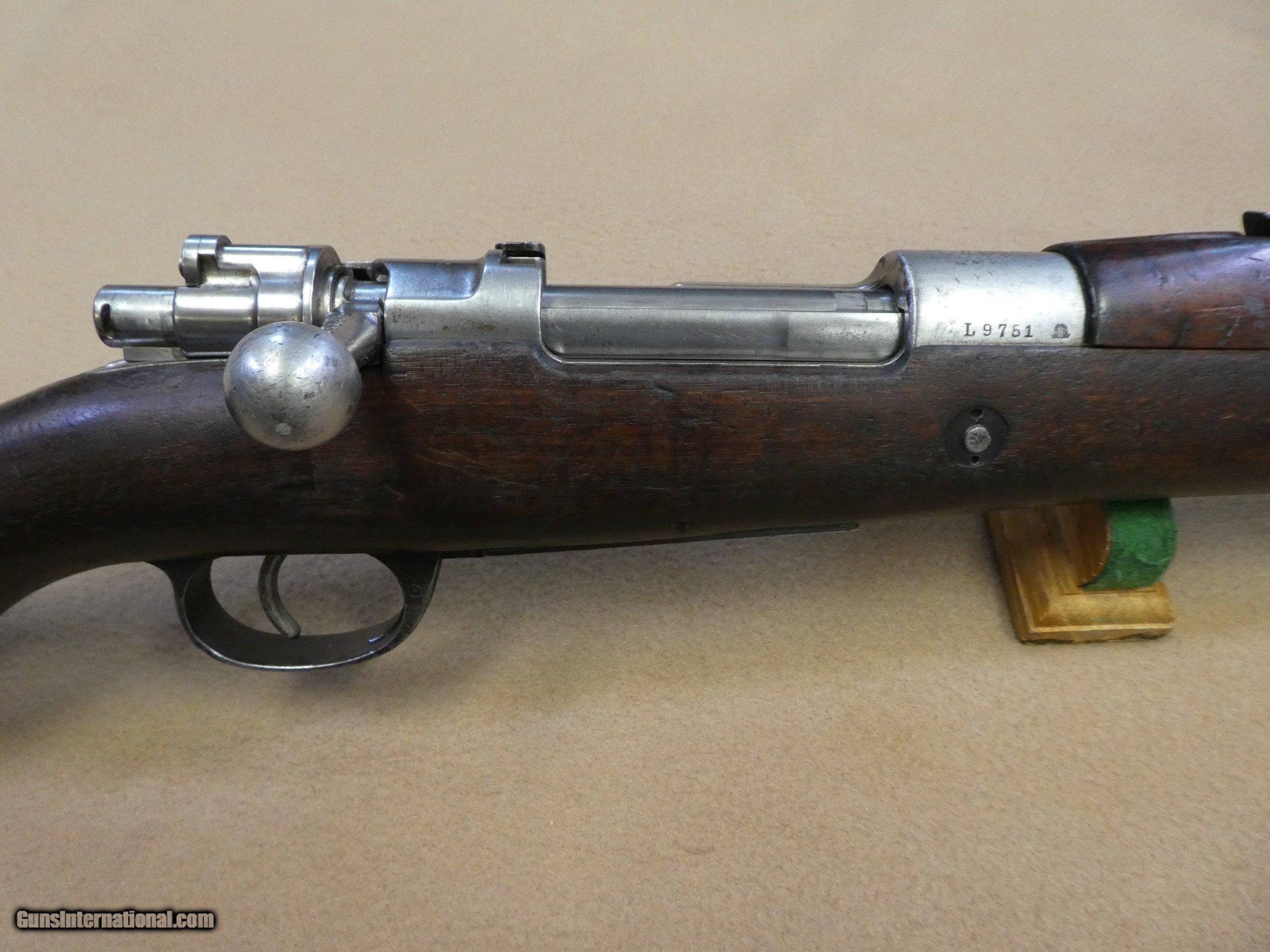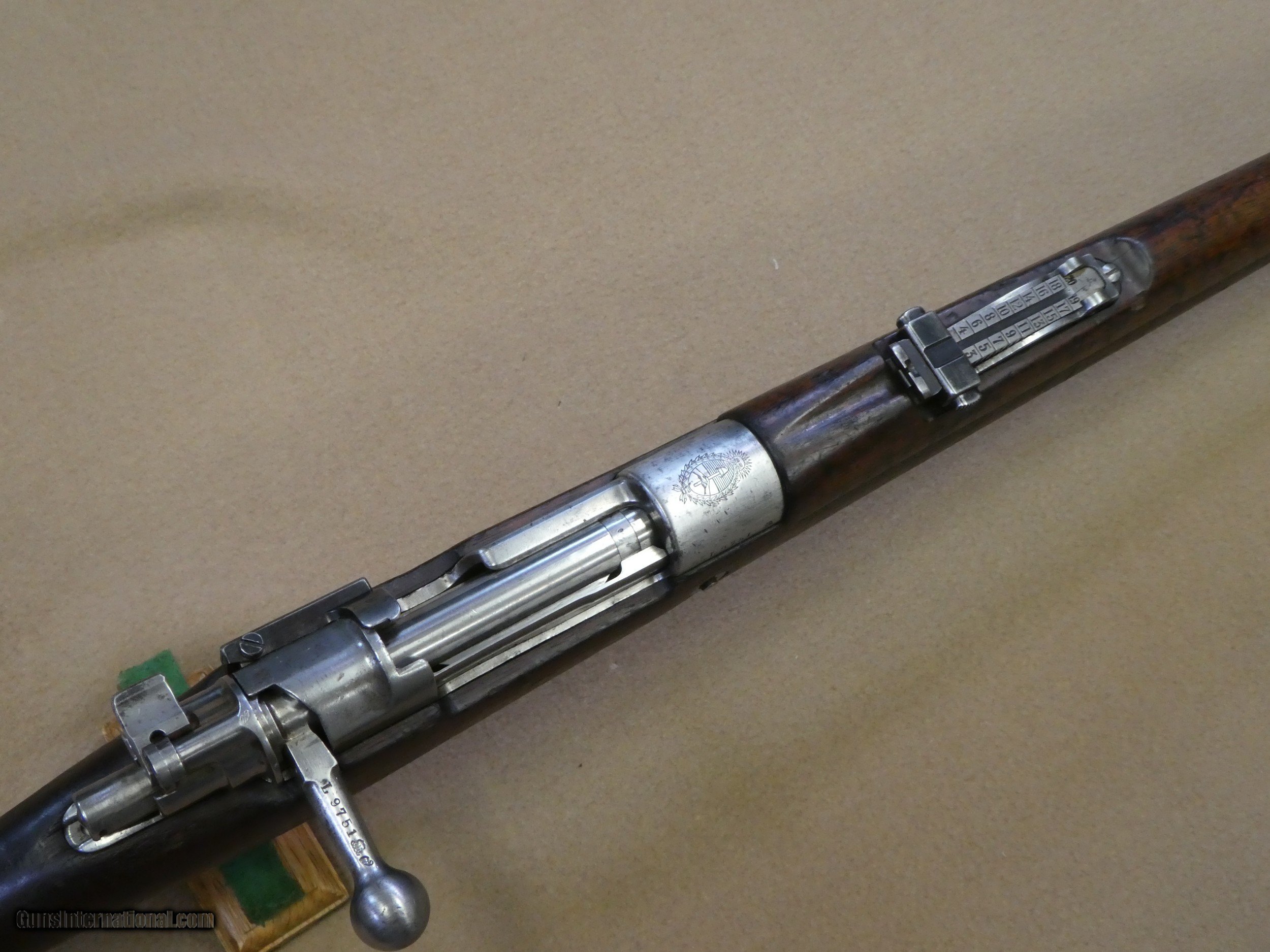The Lil' Argentine 1909 by: | In 1909, Argentina adopted new firearms to replace their 1891 model rifles and carbines. Dubbed the Modelo (model) 1909, the new rifles and carbines were based upon the 98 Mauser rifle design and chambered in the Belgian 7.65x53 Mauser cartridge.
The Argentine Modelo 1909 Cavalry carbine pictured in this article was manufactured by the Deutsche Waffen und Munitions Fabriken, Berlin, Germany (German Arms and Ammunition Factories, Berlin, Germany), also known as DWM, under contract for Argentina. Later model 1909 carbines were also manufactured in Argentina. The 1909 Cavalry carbine is a 98 Mauser with a few variances: - Hinged floor plate, with a release in the front of the trigger guard;
- Shorter length;
- Front sight with protective ears;
- Tangent rear sight;
- Extended bolt release lever; and a
- Full-length Mannlicher style stock.
| | Note the extended bolt release lever that extends to the stripper clip guide. | Argentine Modelo 1909 Cavalry Carbine | Specifications | | Length | 42.5 inches | | Weight | 8.5 lbs. | | Barrel Length | 21.5 inches | | Rifling | 4 groove - right hand twist | | Action | Turn bolt | | Magazine Capacity | 5 |
| | Evaluating the fit and finish of this carbine; I would rate it overall a very highexcellent. Prior to this carbine I have not really ventured out into the world of collecting South American rifles. While performing research for this article I was amazed at the plethora of high quality Mausers for the collector to choose from. No, they are not available in great abundance, but if you keep your eye out at stores and the online auctions (http://www.gunbroker.comand others) you will periodically find good pieces to collect. Because of the artisan level of quality, the 1909 action is highly sought after for the base of custom built sporting rifles. I have one word to describe this little carbine, beautiful. Everything is beautiful from the wood of the stock to the smoothness of the bolt cycling. Not to be too melodramatic but to me it all just whispers - work of art. Military firearms manufactured during the late 19th to early 20th century were for the most part hand made by craftsman and artisans. They cannot be compared to the mass produced firearms we find today that have pressure stamped checkering, machine made laser engravings from a computer developed pattern, and fit and finish that have about as much soul as a cardboard box. The only blemish I found on this particular firearm was that the barrel was counterbored back about a half an inch from the muzzle. Counterboring is where the rifling has been drilled out, back from the crown of the muzzle. This was done usually when the firearm was being arsenal refurbished. The reason for counterboring is because of damaged rifling near the muzzle and this damage usually impacts accuracy greatly. The rifling at the end of the barrel is the most important to putting a good spin on the bullet as it exits the muzzle. The belief is that if you drill out the rifling back from the muzzle until you reach good rifling, this will improve accuracy greatly. I own quite a few rifles (usually Mosin-Nagants) that have been counterbored and are exceptionally accurate. The figure below shows on the left a normal barrel with good rifling and a barrel that has been counterbored on the right.Author's Update Note - 08/09/2004 | | Since the writing of this article I found that the carbine was not counterbored at all. What appeared to be counterboring was actually part of the nose cap that allowed the carbine to support a bayonet being installed. I felt that the counterboring information was still of great value and have chosen to leave it in the article for reference. Surplusrifle.com may at a later date write a stand-alone expanded article on just the subject of counterboring. - Jamie |
| | Figure | Description | | A | Muzzle end view of a normal barrel with good rifling from muzzle to breech. | | B | Muzzle end view of a barrel that has been counterbored, thus with good rifling from counterbore to breech. | | C | Side view of a normal barrel with good rifling. | | D | Side view of a counterbored barrel. Note rifling has been drilled back about a half inch or so until good rifling is found. |
| Argentine Modelo 1909 Cavalry Carbine | Note: Full-length Mannlicher style stock, forward sling swivel, forward sight and sight protective ears. Also note line across stock just forward of rear sight. Originally a copper wire was fitted into the groove to more firmly secure the handguard in place. | Rear sling ring. Note beautiful walnut stock. | Markings on left side of receiver. Deutsche Waffen-Und Munitions Fabriken, Berlin (German Arms and Ammunition Factories, Berlin). | Argentine Coat of Arms | - The human forearms that shake their right hands in the interior frame, represent the union of the populations of the Río de la Plata United Provinces.
- The Phrygian cap is an old freedom symbol and the pike (short lance) displays the aim of defending it, if necessary, with weapons.
- The sun, in its rising position, announced the appearance of a new Nation to the world.
- The laurels are heraldic symbols of victory and triumph, and they are evidence of the victories already obtained in Suipacha and Tucumán.
- With regard to the ribbon bow in the azure, silver (white) and azure colors, similar to the ellipse quarters, it represents the Argentine nationality.
| Source:http://www.argentour.com/ |
| Bottom side of safety lever with very small 'shaking hands' stamp. | The 7.65 Argentine cartridge is called by several other names as well: - 7.65 Mauser;
- 7.65x53 Mauser;
- 7.65 Belgian Mauser.
Originally designed for use in the Belgian 1889 Mauser rifle, many other countries adopted this cartridge in their military arms including: - Spain;
- Turkey;
- Bolivia;
- Colombia;
- Ecuador;
- Paraguay; and
- Peru.
Per Krause Publication's Cartridges of the World they state that the 7.65 Argentine Mauser is probably one of the better Mauser cartridges ever made when it comes to accuracy. The 7.65 Argentine cartridge is very similar in overall specifications and performance to the 7.62 NATO cartridge as the image and comparison table show below. Cases can be formed from .30-06, .270 Winchester, 7mm Mauser, and 8mm Mauser brass cases and should be trimmed to be no longer than an overall length of 2.11 inches. | Side by side comparison of the 7.65 Argentine and the 7.62x51 NATO cartridges | Specification | 7.65 Argentine | 7.62x51 NATO | | Bullet Diameter | .313 | .308 | | Neck Diameter | .338 | .338 | | Shoulder Diameter | .429 | .447 | | Base Diameter | .468 | .466 | | Rim Thickness | .470 | .470 | | Case Length | 2.09 | 2.01 | | Cartridge Length | 2.95 | 2.75 | | Velocity | 2710 | 2750 | | Energy | 2530 | 2520 |
| First 5 shots at 100 yards | | I found the little carbine to be very solid, accurate, and easy to handle. Recoil was mild and the bolt and ejection was positive and flawless. I was able to achieve fairly tight groupings at 100 yards from the bench with the help of a very smooth, two-stage military trigger and excellent sights. In my opinion, the 1909 carbine is comparable in quality to any of the Swedish Mausers, that I so cherish. If you plan on purchasing an Argentine 1909 Mauser then you will find that you have competition.....me. I plan on purchasing more as I find them. | Dear Jamie:
I have just read your very fine article about the Modelo 1909 Mauser Cavalry carbine, and found it very good indeed. I own also a Modelo 1909 Mauser carbine, but not the cavalry type you have but the Engineer's type, that has the same barrel dimensions as the cavalry type but the stock is different, very similar to the Kar98 used by Germany during WW II. It has a turned down bolt handle, like the cavalry model and unlike the infantry rifle, which has a straight bolt handle.
Regarding what you said about the barrel being counter bored at the muzzle, it might not be a counter boring but a bushing welded at the muzzle to allow the use of a bayonet, which was a modification made on these German carbines and on some of the first ones of those made in Argentina in the Domingo Matheu factory in the city of Rosario, between 1947 and 1962. The later ones made in Rosario had a barrel 1/2 an inch longer instead of the welded bushing.
In brief, the Mauser Modelo Argentino 1909 came in three types: 1) Infantry rifle, of 49.21 inches total length and 29 inches barrel length, straight bolt handle, with a four digit serial number preceded by one of the following letters: A, B, C, D, E, F, G, H, I, J, K, L, M, N, O, P, R, making a total of 180,000 rifles.
2) Engineer's carbine, with a total length of 41.89 inches and a barrel length of 21.89 inches, a turned down bolt handle, with a four digit serial number preceded by the letter A only, making a total of 10,000 carbines.
3) Cavalry carbine, like the one you own, total length of 41.57 inches an a barrel length of 21.89 inches, a turned down bolt handle, with a four digit serial number preceded by the letters A, B and C, making a total of 30,000 cavalry carbines. All of these were manufactured in Germany by DWM, and the quality of manufacture is like the one you have described, which makes them a very sought after item. Prices here in Argentina vary from 300 to 350 US dollars in the military surplus stores for conditions good to average.
The cavalry carbine was also manufactured in Argentina, as you said, in the Fabrica Militar de Armas Portatiles (F.M.A.P.) (Light Weapons Military Factory) Domingo Matheu, belonging to the Direccion General de Fabricaciones Militares ( D.G.F.M.) (General Directorship of Military Factories) from 1947 to 1962. These had a six digit serial number, without letters, from 000,001 to 019,989, but some of the intermediate numbers were not used, the approximate number manufactured was 19,800.
The markings on these argentine carbines is of two types:
a) EJERCITO ARGENTINO
MAUSER MOD 1909
D.G.F.M. (F.M.A.P.)
b) F. M. A. P.
MAUSER MOD 1909
DIRECCION GENERAL DE
FABRICACIONES MILITARES
The Domingo Matheu factory also made, under licence from the Colt company, an argentine model 1911-A1, in .45 ACP which is also of very good quality. The approximate number manufactured was 80,000. Other weapons in production under FN licence are the FN-FAL rifle in 7.62x51 (NATO) caliber and the Browning HP39 semiautomatic pistol in 9mm Para caliber.
I hope this info from Argentina will be of interest to all the gun buffs that visit your very fine web-site, please let me know if you find it so.
Best regards and keep up the good work.
Alfredo Fernandez Franzini
|
| | jlm;) | | Sources: | | http://www.argentour.com/ | | NRA Publications: Mauser Rifles | | Military Mauser Rifles of the World, Robert W.D. Ball | | Krause Publication's Cartridges of the World |
|






